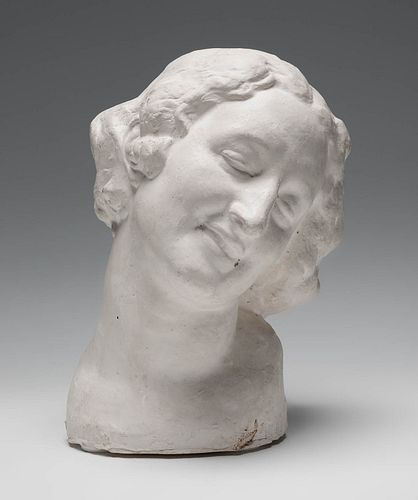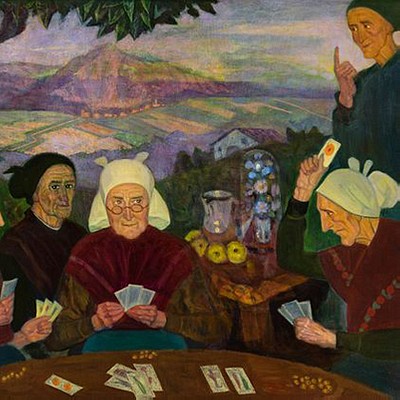JOSEP CLARÀ I AYATS (Olot, Girona, 1878 - Barcelona, 1958). "El somriure" (Portrait of the dancer Isabel Rodríguez), 1914. Plaster.
Lot 40
About Seller
Setdart Auction House
Carrer Aragó 346
Barcelona
Spain
Setdart Subastas was born in 2004 and is currently the first online art auction in Spain with solidity, prestige and reliability guaranteed by our more than 60,000 users. Setdart has a young, dynamic and enterprising team ready to successfully manage the purchase and sale of art works through custom...Read more
Categories
Estimate:
EUR€2,800 - EUR€3,000
$2,916.67 - $3,125
Absentee vs Live bid
Two ways to bid:
- Leave a max absentee bid and the platform will bid on your behalf up to your maximum bid during the live auction.
- Bid live during the auction and your bids will be submitted real-time to the auctioneer.
Bid Increments
| Price | Bid Increment |
|---|---|
| EUR€0 | EUR€10 |
| EUR€200 | EUR€25 |
| EUR€500 | EUR€50 |
| EUR€1,000 | EUR€100 |
| EUR€3,000 | EUR€200 |
| EUR€5,000 | EUR€500 |
| EUR€10,000 | EUR€1,000 |
| EUR€20,000 | EUR€2,000 |
| EUR€50,000 | EUR€5,000 |
About Auction
By Setdart Auction House
Dec 14, 2021
Set Reminder
2021-12-14 08:00:00
2021-12-14 08:00:00
America/New_York
Bidsquare
Bidsquare : 19th & 20th Century Fine Art
https://www.bidsquare.com/auctions/setdart-auction-house/19th-20th-century-fine-art-7992
Gaudi, Sorolla, Torres Garcia, Maclet, TSUGUHARU FOUJITA, Benjamin Palencia Setdart Auction House sofia@setdart.com
Gaudi, Sorolla, Torres Garcia, Maclet, TSUGUHARU FOUJITA, Benjamin Palencia Setdart Auction House sofia@setdart.com
- Lot Description
JOSEP CLARÀ I AYATS (Olot, Girona, 1878 - Barcelona, 1958). "El somriure" (Portrait of the dancer Isabel Rodríguez), 1914. Plaster. Mark of Godard Pere Fondeur, Paris. Signed. Bronze copy published in "Josep Clarà, els anys de París, 1900-1931. L'ànima vibrant", with texts by Eva Vázquez, Mercè Doñate, Lluís Muntada, Mariàngela Villalonga and Manuel Loosveldt. Measurements: 35 x 24 x 26 cm. Josep Clarà began his training at the School of Drawing in Olot, with Josep Berga i Boix, and later studied sculpture at the School of Fine Arts in Toulouse, France. After finishing his studies, he went to Paris in 1890, where he worked in the workshop of Louis Barrias and met Maillol, Bourdelle and Rodin. In fact, the advice of the latter helped him to overcome the modernist influences of his early works. In 1907 he presented the work "Torment" at the Salon des Artistes Français, a work that denotes a Rodinian influence that in his marble "Twilight" (1913, Museo de Santiago de Chile), whose plaster model he presented at the Salon de la Société Nationale in 1908, is diluted in favor of greater clarity and serenity. The following year he presented what would be the first of his goddesses, a work that finally represented the definitive official recognition of his talent. During these years, his friendship with the dancer Isadora Duncan allowed him to create his most original and spontaneous drawings; the dynamism of dance did not contradict his search for stability, and brought him a serene light and vivacity. A tireless worker, he received several commissions for monuments, such as "Serenity on the ruins of life" (San Isidro cemetery, Madrid) and "Monument to the Catalan volunteers" (Ciutadella Park, Barcelona). With the model of the latter he won the grand prize in Paris in 1925. At the end of that same year he was appointed member of the Academy of Fine Arts of San Fernando in Madrid. Clarà also made heads and portraits, where he showed a condensed and lively language: "Voluntad" (1911), "Clara Stuart Merrill" (1926), "Adela" (1936), "Señorita Rodríguez Bauzà" (1941). As time went by, the sculptor gave more and more importance to light, and his sculptures became simpler, freeing himself from all sentiment, as can be seen in his first "Static", from 1926. With this new vision, in 1928 he reinterpreted "Diosa" and "Serenidad" (Montjuic garden, Barcelona), and created "Reposo" (MACBA), which won him the medal of honor at the International Exhibition of Barcelona (1929). In 1930 Clarà traveled to Greece; two years later he left his residence in Paris and settled permanently in Barcelona. In 1934 he was awarded the Damià Campeny prize for "Desnudo de muchacha". In 1936 he created one of his best works, for the synthesis of simplicity, light and serenity: "Pujanza". He is also the author of the "Monument to the Fallen" (1952) in Barcelona.) With the nude "Pomona" (Museum of Havana) he won the grand prize at the 1954 Hispano-American Biennial. In 1946 he made a "San Benito" (Montserrat) that oriented him towards the study of the seated figure. Thus, his last works will be mainly seated maternities and lying figures. In 1969 was inaugurated in Barcelona the museum that bears his name, where a large part of his work is preserved. It is also present in the Regional Museum of Garrotxa in Olot and the National Art Museum of Catalonia, among others.
- Shipping Info
-
In-house shipping available. Please inquire at admin@setdart.com.
-
- Buyer's Premium



 EUR
EUR CAD
CAD AUD
AUD GBP
GBP MXN
MXN HKD
HKD CNY
CNY MYR
MYR SEK
SEK SGD
SGD CHF
CHF THB
THB













